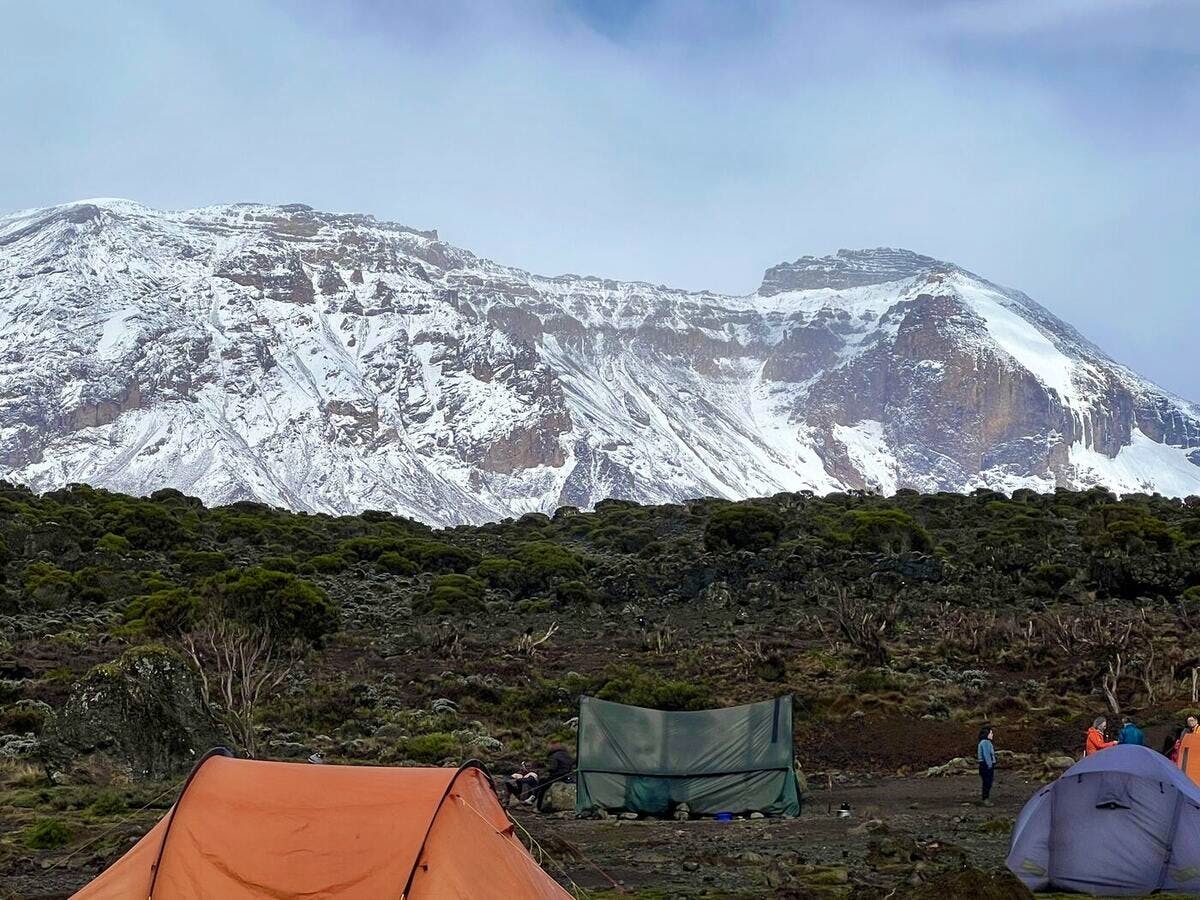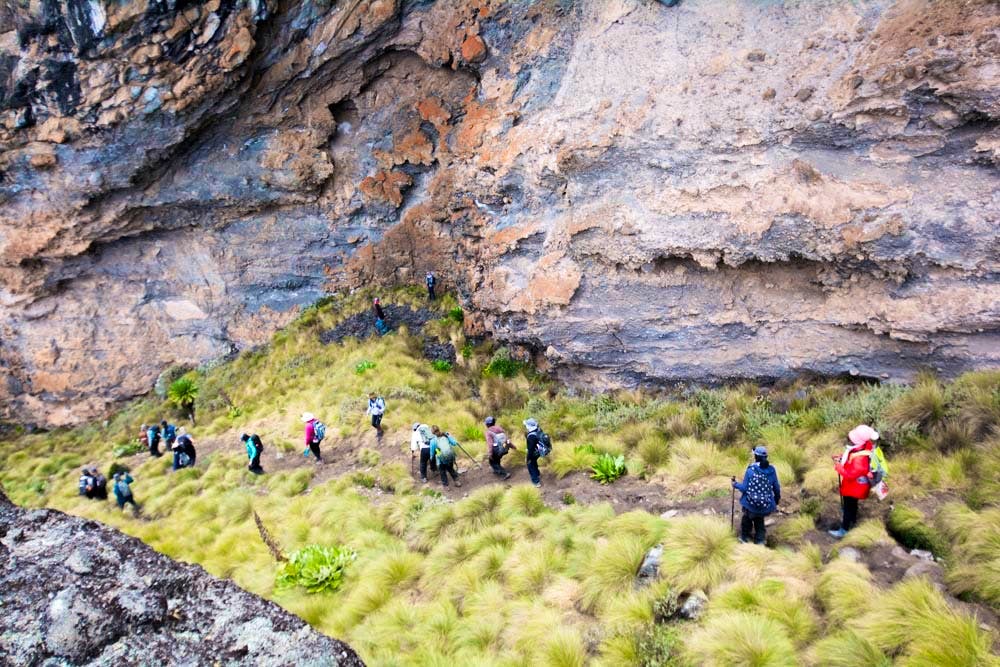Mount Kenya vs Kilimanjaro - Two East African Adventures!
Mount Kenya vs Kilimanjaro – which one's for you? These mountains stand tall in East Africa, each promising unique challenges and breathtaking views.
At Skyhook, we understand the altitude, terrain, and what makes each mountain tick. Book a trip on either mountain with us to get a professionally planned itinerary, as our trusted local guides lead you up for an adventure-filled journey.
But first, let's give you the facts about Mt Kilimanjaro and some Mount Kenya facts to help you decide where your next hiking adventure should unfold.
What is the Difference Between Mount Kenya and Mount Kilimanjaro?

Mt Kenya
Mount Kenya, proudly soaring into the African sky, stands at an impressive 5,199 metres (17,057 feet) above sea level.
Its distinct jagged peaks punctuate the horizon, drawing climbers into a realm where the air thins and the world below transforms into a patchwork of greenery.
With its diverse ecosystems, Mount Kenya hosts stunning flora and fauna, from equatorial forests to alpine meadows. Its allure lies in climbing Mount Kenya and the journey through these vibrant landscapes.

Mt Kilimanjaro
Casting a commanding presence on the Tanzanian skyline, Mount Kilimanjaro, the highest point in Africa, reaches an awe-inspiring 5,895 metres (19,341 feet) above sea level.
This dormant volcano captivates the imagination with its iconic snow-capped summit, creating an imposing silhouette against the African plains.
Kilimanjaro invites adventurers to traverse five distinct climate zones, each with its own character. Kilimanjaro's journey is a climactic odyssey from lush rainforests to arctic conditions near the summit.
Here's our detailed Mount Kilimanjaro guide to get you ready!
Mount Kenya Vs. Kilimanjaro: Location and Geography
Mount Kenya stands on the equator, piercing through the Kenyan sky. Its surroundings are a breathtaking blend of lush landscapes and diverse ecosystems.
As you approach, the lower slopes are adorned with dense equatorial forests, gradually giving way to Afro-alpine meadows. The mountain's iconic peaks, Batian, Nelion, and Lenana, rise dramatically above the sprawling greenery.

The allure of Mount Kenya extends beyond its slopes. The surrounding region offers captivating attractions like the Aberdare Range to the east and the stunning Rift Valley to the west.
Wildlife enthusiasts can explore the Mount Kenya National Park and Ol Pejeta Conservancy of animals where great African species roam freely.
Mount Kilimanjaro dominates the Tanzanian skyline, a solitary giant amidst the plains. Its lower reaches feature lush rainforests that contrast with the arid savannah below. As you ascend, the landscape transitions through heath and moorland for visual biodiversity.
Kilimanjaro's influence extends to nearby attractions like the Serengeti National Park and the Amboseli National Park.

The mountain's proximity to these wildlife havens allows hikers to combine their adventure with glimpses of Africa's iconic fauna and Mount Kilimanjaro animals.
While both mountains are in East Africa, their geographical nuances are distinct. Mount Kenya features diverse flora on its slopes, and the proximity to wildlife-rich areas provides a sense of natural immersion.
Kilimanjaro, on the other hand, asserts its grandeur against the vast Tanzanian plains. The expansive view from Kilimanjaro from its slopes offer a sense of conquering a colossal landmark on the African continent.
Weather conditions on Mt Kenya Vs. Kilimanjaro
Mount Kenya and Kilimanjaro experience similar weather patterns throughout the year due to their closeness to the equator. The mountains enjoy relatively dry conditions from January to February and July to September, making these periods ideal for trekking.
March to June and October to December bring long and short rains, making the trails slippery and challenging. The temperature, influenced by altitude, ranges from mild at lower elevations to freezing near the summit.
Still, the location on the equator makes Mt Kenya's weather more unpredictable than Mt Kilimanjaro's weather.
In comparing the two, Mount Kenya's weather demands agility and readiness for abrupt changes, while Kilimanjaro's equatorial consistency allows for more strategic planning.
Consider your tolerance for variability when choosing between these East African giants, where weather becomes integral to the adventure narrative.


Latest Deals
Mt Kenya Vs. Kilimanjaro Difficulty Levels
While less technically demanding than peaks like Everest Base Camp or Tour du Mont Blanc, Mount Kenya still requires a mix of skills.
You must be adept at rock scrambling and navigating uneven terrain. The higher reaches may involve basic ice and snow skills (see our ice climbing guide here), especially on the summit peaks of Batian and Nelion.
Thus, a well-rounded skill set is essential for conquering the varying technical demands of Mount Kenya.
Kilimanjaro is renowned for being a non-technical climb, making Kilimanjaro difficulty easier for many climbers. The ascent primarily involves hiking, with no need for advanced technical skills like rock climbing or using specialised equipment.
However, the altitude and length of the climb demand good physical conditioning and mental resilience.

Mt Kenya Vs. Kilimanjaro Distance and Duration
Mt Kenya
Mount Kenya offers various routes with unique characters and duration.
The Naro Moru Route, known for its direct ascent, usually takes 4 to 5 days. The Chogoria Route, weaving through striking landscapes, extends the journey to 5 to 7 days. The Sirimon Route, with its scenic beauty, shares a similar timeline.
The technical climbs to Batian and Nelion may add extra days for those seeking the ultimate challenge.
The distances on Mount Kenya vary based on the chosen route. On average, expect to cover approximately 60 to 70 kilometres (37 to 43 miles) in the round-trip ascent journey. The variations in terrain and elevation contribute to the diversity in distances across different routes.

Mt Kilimanjaro
Mount Kilimanjaro boasts several routes, each offering a unique mountain perspective.
The Marangu Route, known as the "Coca-Cola" route, takes 5 to 6 days. The Machame Route, dubbed the "Whiskey" route, extends the trek to 6 to 7 days, providing a more gradual ascent. The Lemosho Route shares a similar Kilimanjaro climb time.
The longer Northern Circuit Kilimanjaro and Kilimanjaro Western Breach routes offer extended adventures for those seeking a more immersive experience.
The average distances covered on Kilimanjaro range from 65 to 75 kilometres (40 to 47 miles), depending on the chosen route.
The length of the climb, coupled with the gradual elevation gain, allows for a manageable yet challenging trek, providing ample time for acclimatisation.
Mt Kenya Vs. Kilimanjaro Success Rates
With its rugged terrain and challenging landscapes, Mount Kenya sees around 15,000 visitors annually. This indicates a more secluded and demanding experience.
In contrast, Mount Kilimanjaro attracts about 30,000 adventurers each year and boasts an average Kilimanjaro summit success rate of approximately 65% across all climbers and routes. Some routes on Kilimanjaro, such as the Rongai Route, even report success rates as high as 90%.
This difference suggests that with its more established routes and infrastructure, Kilimanjaro offers climbers a higher likelihood of reaching the summit than the more challenging Mount Kenya.
Altitude and Acclimatisation on Mt Kilimanjaro Vs. Mt Kenya
Both mountains demand careful consideration of altitude-related challenges and strategic acclimatisation planning.
While Mount Kenya offers flexibility in route selection to cater to individual preferences, Kilimanjaro's longer routes often present a more gradual and accommodating acclimatisation process.

Accommodation on Mt Kenya Vs. Kilimanjaro
Accommodation on Mount Kenya caters to a diverse range of preferences. Base camps, strategically located at different altitudes, serve as resting points for climbers.
These camps often provide basic facilities like bunkhouses or mountain huts, allowing you to relax and recharge.
Higher-altitude camps may offer basic accommodations due to the challenging logistics of delivering services at such elevations.

Kilimanjaro's base camps are strategically positioned along its various routes.
Kilimanjaro camps like Horombo Hut on the Marangu Route or Barranco Camp on the Machame Route provide essential shelter.
Some routes, like the Northern Circuit, offer more exclusive tented camps, providing luxury in the high-altitude wilderness.
Mount Kenya's accommodations emphasise a more rustic experience, fostering a sense of shared adventure. With its diverse options, Kilimanjaro provides a spectrum of comfort, allowing climbers to tailor their experience.
The choice between the two involves balancing the desire for amenities with the rugged appeal of high-altitude refuge.

Conclusion
In the choice between Mount Kenya vs Mount Kilimanjaro lies an adventure tailored to your spirit.
Mount Kenya captivates with its diverse ecosystems and technical challenges, promising an intimate connection with nature. Kilimanjaro, an imposing figure against the Tanzanian plains, invites adventurers to a non-technical climb through diverse climates.
So, what are you waiting for? Explore their unique terrains by booking your seat on our Mount Kenya trips and for an authentic and fulfilling expedition with us at Skyhook Adventure.
Skyhook's Kenya and Tanzania Tours
Skyhook's Mt Kilimanjaro Trips
Find your next adventure
Why Skyhook?
Join over 27,000 Skyhook adventurers who've used our platform to book directly with our vetted local guides, at local prices (we never markup).
Expert Local Guides
Experienced local guides, handpicked by us.
Best Prices
Never pay a markup on the local guide's price.
Exclusive Club
Earn loyalty rewards every time you travel.
Great Social Vibes
Small group tours provide a richer experience.
Stellar Feedback
Over 2,800 reviews, average of 4.9/5 stars.












